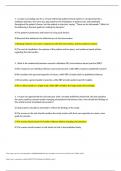Exam (elaborations)
Past 10 years of Exam (SOLVED) BMI2604 - Molecular Biology of the Cell
- Course
- Institution
- Book
Unlock your potential with this invaluable resource for BMI2604 - Molecular Biology of the Cell! This document is a meticulously compiled collection of solved exam papers from the past ten years, designed to help you excel in your studies and ace your exams. Whether you're a current student or prep...
[Show more]













